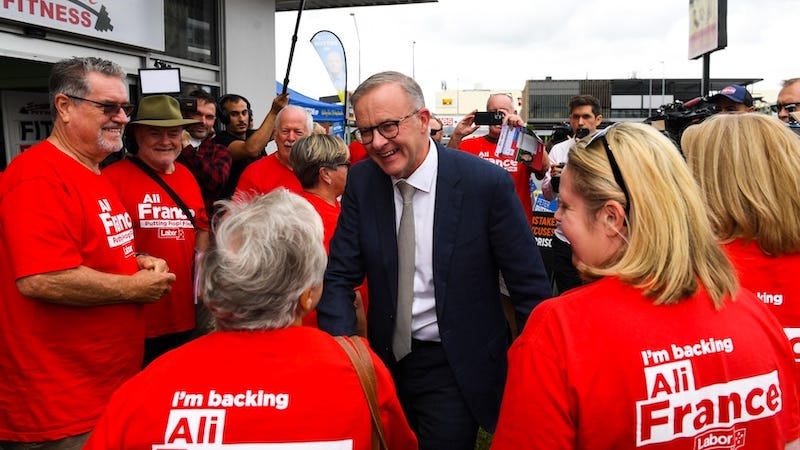Australia’s poll frenzy: Don’t believe the pro-Dutton spin
If Labor wishes to hold on to power, it will need the same force of vision that once defined the party’s greatest leaders.
The recent release of a batch of opinion polls has unleashed a fury of media attention, with the narrative forced down our throats that the Liberal and National Coalition are set to win the next federal election. The YouGov/MRP poll – the one that got all the attention – delivered its headline forecasting a Coalition win and the supposed crowning of Dutton as the 32nd prime minister, who’ll be soon residing in The Lodge. The basis for these claims remains tenuous – aside from the small matter of an election that has to be held before these claims can be made, and it’s the electorate that makes the decision, not the opinion pollsters – nevertheless, the mainstream media seized upon the poll’s figures with their usual enthusiasm, pushing the idea that a new era of conservative leadership was imminent, with a big hooray!
This was taken to fever pitch by other outlets such as the ABC, which hyped the possibility of a Dutton-led government and eagerly speculated on what Coalition policies might mean for everyday Australians. While the public coverage has been breathless, one can’t ignore the gleeful tone of certain commentators who seem more than happy to help paint the Coalition’s path to victory as a fait accompli, one that will be surely rubber-stamped by the electorate at the next election.
However, beneath the headlines – the ones that are verging on propaganda or are actual propaganda – a more cautious view suggests that these polling numbers are far from conclusive. The YouGov/MRP data indicated a two-party-preferred figure of 49 per cent for Labor and 51 per cent for the Coalition, with the claim that the Coalition was well-positioned to form a minority government. Poll-driven coverage often benefits the pollsters themselves, who receive substantial publicity and reinforce their own brands each time a “shock” result or dramatic insight captivates the press.
It also meets the mainstream media’s hunger for compelling narratives that keep audiences engaged and promotes a conservative agenda. Casting Labor in a precarious position suits the interest of media outlets that thrive on the spectacle of tight electoral contests – and once again, it’s the spectacle of what the academic Jay Rosen refers to as horse-race journalism. While it remains possible that the poll’s prediction might prove accurate, it is essential to note that highly speculative figures do not translate to guaranteed outcomes. The real test takes place on election day, and these sorts of data points – published months out from the election – risk becoming self-fulfilling prophecies only if they generate so much noise that they start to influence voter perception and behaviour. Yet it is worth remembering that polls provide no ironclad certainty, especially when they contradict each other and fail to demonstrate strong consistency.
Further complicating the picture is the divergence of results across other pollsters. Resolve, through Nine Media, reported a far wider gap, with a 55–45 per cent split favouring the Coalition, as if to say “that’s not a headline, this is a headline”. This finding was splashed across newspapers and online forums, seemingly confirming the idea that Labor’s position was on shaky ground and they were definitely on track to the lose the next federal election.
But an almost concurrent Morgan poll that had Labor at 51.5 per cent and the Coalition at 48.5 per cent almost received no media attention at all. This selective reporting – in which polls featuring dramatic, headline-grabbing numbers receive more coverage – highlights the tendency for the media to elevate stories that feed sensational narratives, while more moderate or contradictory data is minimised or just ignored. The result is a skewed picture for the public, with each polling result touted or downplayed depending on how well it supports the storyline that a new Coalition government under Dutton is on the horizon. And, to use the words of former prime minister, Paul Keating, who described Dutton as the “most wicked and cynical of individuals”, God help us.
Amid all the noise, the practical question of how any incoming prime minister would form government remains unanswered. Manufactured rumours are swirling about which independents or smaller parties might be willing to line up with the Liberal and National Coalition if a hung parliament eventuates. The community independents, who largely parted ways with the Liberal Party over policy differences that reflect “Dutton-esque” hardline stances, are not an obvious fit for a Coalition agreement. Why would they be?
Similarly, Bob Katter, might not be guaranteed to align with the Coalition simply because of his usual conservative leanings. Political negotiations involving independents rarely occur in a vacuum of left vs. right calculations, as we saw in 2010, when the right-leaning independents Tony Windsor and Rob Oakeshott guaranteed a minority government for Julia Gillard, rather than side with the conservative Tony Abbott; personal relationships, local concerns, and policy priorities all factor into how votes on the floor of parliament align.
The increasingly dire opinion polling picture for Labor, at least as presented by the sensational media coverage, has overshadowed these nitty-gritty details of potential post-election horse trading. Nonetheless, these details matter, since they will shape whether a minority government can even be formed by the Coalition, let alone governed effectively over a full term. In the end, the real power remains with Australian voters, who tend to be cautious about delivering sweeping changes unless there is a strong impetus to do so. Historical voting patterns suggest that electorates do not usually shift dramatically unless confronted by significant dissatisfaction or compelling alternatives.
For all the talk of a “predestined” future prime minister in Dutton, the evidence for such a prediction in the recent polls is not as rock solid as the media frenzy would suggest. It’s a cliché but the only poll that matters is on election day, and while some journalists and commentators continue to promote the sensational possibilities highlighted by YouGov/MRP and others, a more measured analysis calls for a significant level of skepticism.
It is entirely possible that a minority Labor government could still emerge from these same numbers, once the independent seats and coalition-building realities come into play. Even if the polling remains shaky in the lead-up, election outcomes depend on a mixed web of preferences, regional fluctuations, last-minute swings, and the elusive mood of the electorate, none of which can ever be perfectly captured by a single poll or even a series of them.
An uncharted political terrain: Why predictions will fall flat at the next election
In the lead-up to an election already defined by headline-grabbing polls and breathless media coverage, the biggest revelation has been how deeply the uncertainty has set in. While most of the commentary has concentrated on the shortcomings of both Anthony Albanese and Dutton as prime ministers, there is a more seismic factor looming: an estimated 42 per cent of the electorate now plans to vote for minor parties or independents. This shift brings an unpredictable measure that neither major party can confidently navigate, no matter how many polls or pundits predict otherwise – what we are witnessing is the accelerated erosion of the two-party system’s dominance.
With such a large proportion of votes likely to fall outside the traditional Coalition-versus-Labor, the critical issue at the next election will be how preferences flow and how effectively each party adjusts to this splintered environment. Governments can usually rely on incumbency to have the polling numbers drift back to them as the election day becomes nearer. However, the conventional notion that elections are decided on the single day at the ballot box is quickly becoming outdated – in recent elections, almost half of the electorate has voted in the two or three weeks of the prepoll period, and this factor is forcing campaigns to sustain their messaging and momentum over a longer period of time. Parties that treat those final fourteen days as just a prelude to election day risk forfeiting a large level of potential support to opponents or to the minor parties and community-backed independents who have become increasingly adept at targeting local concerns.
This more fluid environment also aligns with ongoing generational and philosophical evolutions in Australian politics. Voters are no longer content to accept party machines designed in the industrial ages, when labor and capital were the core political battlegrounds. The rise of concerns such as climate change, technological disruption, and cultural diversity has strained these old frameworks. When 42 per cent of people gravitate to minor parties or independents, it’s because they are not finding answers in the traditional spectrum of left versus right within the major parties, but are instead searching for candidates and platforms that align more closely with specific policy priorities or localised viewpoints.
In this context, the big parties may find many of their long-held beliefs or strategies rendered not necessarily wrong, but irrelevant. Consequently, it is entirely possible that every bit of conventional wisdom regarding party swings, incumbency benefits, and leadership drags may break down in the face of a fast-changing political landscape, leaving pundits and pollsters scrambling to explain an outcome few had foreseen.
When caution becomes a liability: Labor’s timidity has given Dutton a platform
It remains seriously bewildering that a Labor government finds itself languishing in the polls against Dutton – even though these are just opinion polls – many consider Dutton to be among the least capable opposition leaders in recent Australian political history and totally unfit to be the prime minister. There are many factors here: Albanese’s attempt to lower the political temperature, as he said soon after becoming prime minister – a move initially welcomed by a public weary of relentless combativeness.
Yet, by pulling back so far, Labor has surrendered the narrative to the Coalition, allowing it to frame debates and fill the media vacuum with noise and political theatre. This style of “quiet” leadership might have soothed the electorate in less tumultuous times, but in a climate where opinion polls already struggle to account for the massive 42 per cent supporting minor parties and independents, a lack of boldness has given the Coalition room to seize the agenda.
Labor’s core dilemma is that it is no longer enough simply to coast on incumbency. There is a nostalgia for leaders such as Whitlam, Hawke, Keating, and even Rudd or Gillard, and all of them carried grand ambitions when they were in office. By comparison, Albanese’s incremental approach, designed to avoid the pitfalls of polarising conflict, has done little to energise the base or capture the enthusiasm of the public.
Even if there are strong arguments for a more measured style of governance – particularly in an era keen to reject the hyper-partisanship that has permeated politics globally – those arguments lose weight when a government slips behind in the polls to a party thought by many to be in internal disarray. Add to this the sobering memories of 2019, when Bill Shorten was widely expected to become prime minister right up until the point that he wasn’t, and Labor’s margin for error narrows further. Polls can be fickle and sometimes fail to detect shifts in public sentiment until it is too late, yet they still set narratives that influence whether a political party is viewed as confident or vulnerable.
The historical parallel with John Hewson’s failed bid in 1993 highlights how a supposedly lacklustre government can still outsmart an opposition leader plagued by overconfidence. Just as Hewson was undone by a combination of unpopular policies and campaign missteps despite vocal media backing, there are clear pathways for Dutton to stumble spectacularly. His popularity numbers, while occasionally buoyed by headlines predicting a miracle Coalition comeback, still fall short of the massive advantage required to snatch a substantial number of seats from Labor in a single election. A wide gulf separates media hype from concrete electoral gains – yet each day that passes without a clear, stirring vision from Labor makes it more feasible for the Coalition to cobble together enough momentum to threaten a return to government.
The final challenge for Labor is that its timid approach is unfolding in an era of rapid political transformation. If Labor persists with a defensive strategy, it risks further losing support to newcomers in the electorate – the community independents – and to the Australian Greens or other minor parties. No amount of incumbency advantage can fully withstand a rising tide of disillusionment when policy ambition appears lukewarm.
In a contest already described as one of the most unpredictable in decades, it is possible the government will still prevail once voters take a closer look at Dutton in a full campaign spotlight – he has avoided scrutiny for most of this parliamentary term but during an election campaign, there is nowhere to hide. However, without a clear sense of bold purpose, Labor could inadvertently transform an ordinary and mediocre opponent into a genuine threat. In a political environment this volatile, caution can become a liability faster than any poll can predict, and if Labor wishes to hold on to power, it will need the same force of vision that once defined the party’s greatest leaders.












A well written analysis David and Eddy.
I think the key for the polling has to be looking at the sun-national polling at State Levels. It’s clear from that polling that the ALP is struggling much more in NSW and Victoria. While yes preferences may come back to them, polling in the low 30s and 20s ought to be subject to critical viewing as it just makes it harder for the ALP to win seats in suburban Melbourne and Sydney.
The geographical concentration of the vote for the ALP appears stable in SA, WA and TAS. In QLD they may get one or two seats off the Greens if it is a close 3-way contest, but the margins are so high for the LNP federally in QLD there are slim pickings. This is why if it were proportional representation we wouldn’t have to worry about the LNP forming government with a sub 50% primary vote.